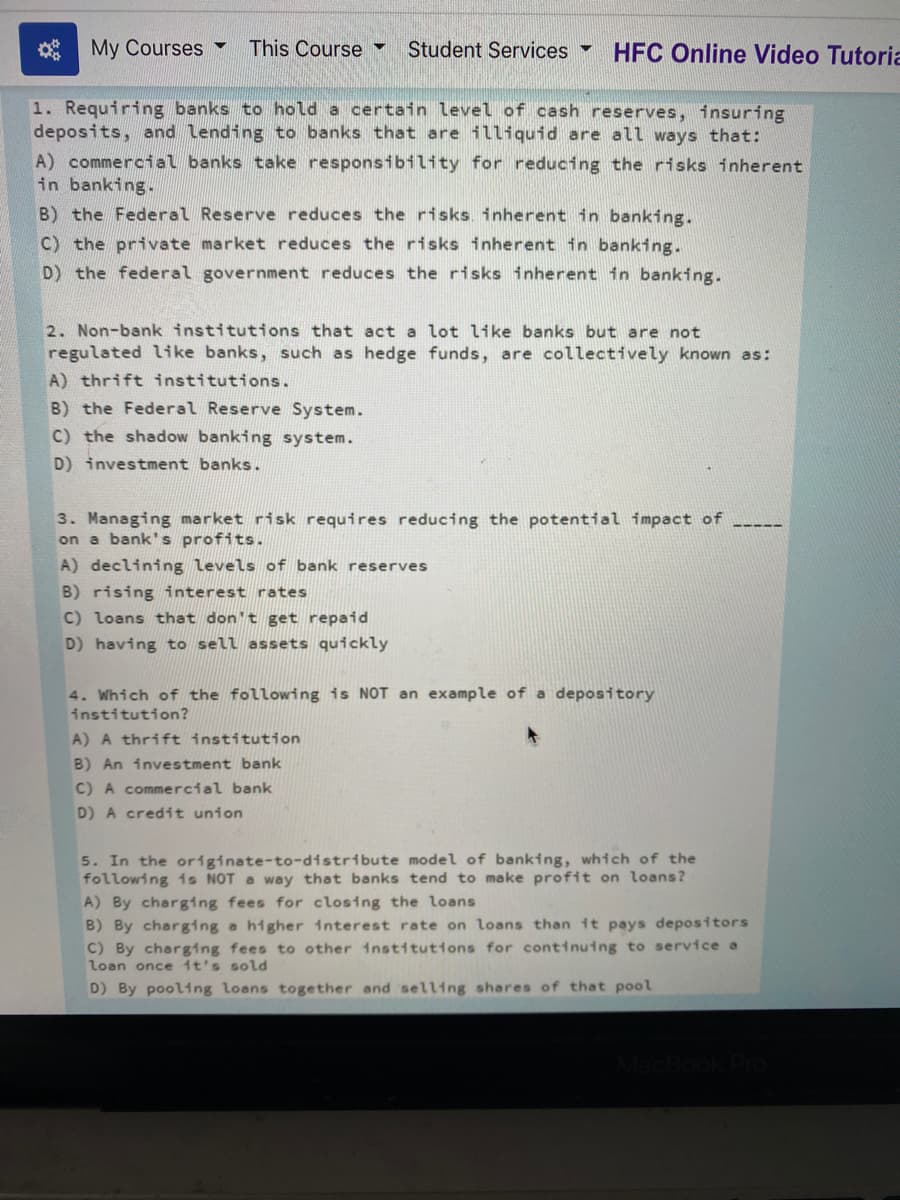1. Requiring banks to hold a certain level of cash reserves, insuring deposits, and lending to banks that are illiquid are all ways that: A) commercial banks take responsibility for reducing the risks inherent in banking. B) the Federal Reserve reduces the risks. inherent in banking. C) the private market reduces the risks inherent fn banking. D) the federal government reduces the risks inherent in banking.
1. Requiring banks to hold a certain level of cash reserves, insuring deposits, and lending to banks that are illiquid are all ways that: A) commercial banks take responsibility for reducing the risks inherent in banking. B) the Federal Reserve reduces the risks. inherent in banking. C) the private market reduces the risks inherent fn banking. D) the federal government reduces the risks inherent in banking.
Essentials of Economics (MindTap Course List)
8th Edition
ISBN:9781337091992
Author:N. Gregory Mankiw
Publisher:N. Gregory Mankiw
Chapter21: The Monetary System
Section: Chapter Questions
Problem 4PA
Related questions
Question

Transcribed Image Text:* My Courses
This Course
Student Services HFC Online Video Tutoria
1. Requiring banks to hold a certain level of cash reserves, insuring
deposits, and lending to banks that are illiquid are all ways that:
A) commercial banks take responsibility for reducing the risks inherent
in banking.
B) the Federal Reserve reduces the risks. inherent in banking.
C) the private market reduces the risks inherent in banking.
D) the federal government reduces the risks inherent in banking.
2. Non-bank institutions that act a lot like banks but are not
regulated like banks, such as hedge funds, are collectively known as:
A) thrift institutions.
B) the Federal Reserve System.
C) the shadow banking system.
D) investment banks.
3. Managing market risk requires reducing the potential impact of
on a bank's profits.
A) declining levels of bank reserves
B) rising interest rates
C) loans that don't get repaid
D) having to sell assets quickly
4. Which of the following is NOT an example of a depository
institution?
A) A thrift institution
B) An investment bank
C) A commercial bank
D) A credit union
5. In the originate-to-distribute model of banking, which of the
following 1s NOT a way that banks tend to make profit on loans?
A) By charging fees for closing the loans
B) By charging a higher interest rate on loans than it pays deposttors
C) By charging fees to other institutions for continuing to service a
loan once 1t's sold
D) By pooling loans together and selling shares of that pool
Expert Solution
This question has been solved!
Explore an expertly crafted, step-by-step solution for a thorough understanding of key concepts.
This is a popular solution!
Trending now
This is a popular solution!
Step by step
Solved in 2 steps

Knowledge Booster
Learn more about
Need a deep-dive on the concept behind this application? Look no further. Learn more about this topic, economics and related others by exploring similar questions and additional content below.Recommended textbooks for you

Essentials of Economics (MindTap Course List)
Economics
ISBN:
9781337091992
Author:
N. Gregory Mankiw
Publisher:
Cengage Learning

Brief Principles of Macroeconomics (MindTap Cours…
Economics
ISBN:
9781337091985
Author:
N. Gregory Mankiw
Publisher:
Cengage Learning

Economics (MindTap Course List)
Economics
ISBN:
9781337617383
Author:
Roger A. Arnold
Publisher:
Cengage Learning

Essentials of Economics (MindTap Course List)
Economics
ISBN:
9781337091992
Author:
N. Gregory Mankiw
Publisher:
Cengage Learning

Brief Principles of Macroeconomics (MindTap Cours…
Economics
ISBN:
9781337091985
Author:
N. Gregory Mankiw
Publisher:
Cengage Learning

Economics (MindTap Course List)
Economics
ISBN:
9781337617383
Author:
Roger A. Arnold
Publisher:
Cengage Learning


